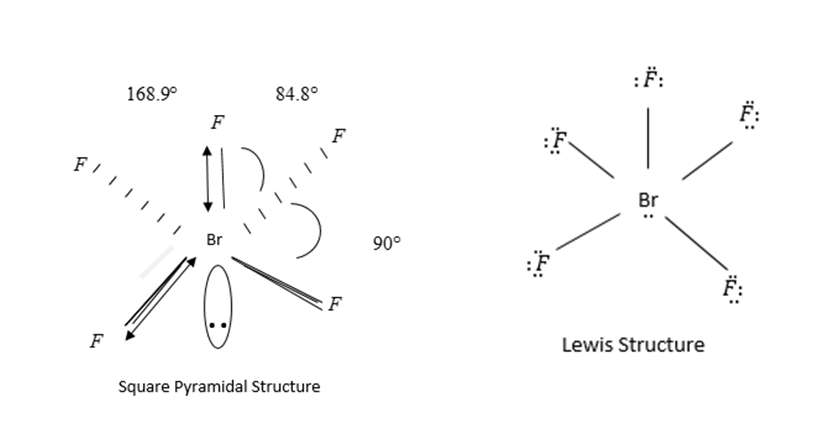
Select correct statement for $Br{F_5}.$
(A) All fluorine atoms are in the same plane.
(B) Four fluorine atoms and Br atoms are in the same plane.
(C) Four fluorine atoms are in the same plane.
(D) It has\[F - Br - F\]bond angles at ${90^\circ }.$
Answer
220.8k+ views
Hint: $Br{F_5}$ is an interhalogen compound. When two different halogens form compounds among themselves, interhalogen compounds are formed. Such compound may have general formula $X{X^1},XX_3^1,XX_5^1$ and $XX_7^1.$ Here $X$ is halogen of large size and ${X^1}$of small size and $X$ is more negative.
Complete step by step answer:
In $Br{F_5}$Bromine is the central atom and fluorine atoms present around it.
The name of the compound is Bromine pentafluoride.
Bromine atoms have larger size than fluorine and fluorine is more electronegative.
Electronic configuration of Br, $1{s^2}2{s^2}2{p^6}2{s^2}3{p^6}3{d^{10}}4{s^2}4p_x^24p_y^24p_z^1$
Ground state configuration =

Excited state configuration =

Hybridized state =

Geometry of $Br{F_5}$ is square pyramidal and hybridization $s{p^3}{d^2}.$
In $s{p^3}{d^2},$ 4 Fluorine atoms and one Br-atom present in the same plane.
Bond angle between them is 90 Degrees.

In Lewis structure we see that octets of each element should be complete. On fluorine atoms 3 lone pairs of electrons and on bromine atom only one lone pair is present.
By VSEPR theory 4 bond pairs occupy corners of squares and one bond pair and lone pair of electrons occupy equatorial position to minimize repulsion between lone pair and bond pair of electron.
Interhalogen compounds are covalent in nature due to low electronegativity difference between halogens. They are diamagnetic in nature. They are more reactive than halogen.
Interhalogen compounds behave as strong oxidizing agents and attack other elements to give a mixture of halides.
Therefore, the above explanation, the correct option is [D] Both assertion and reason are incorrect.
Note: Interhalogen compounds are more reactive than halogen. This is because the $X - {X^ - }$ bond present in them is weaker than $X - X$ and${X^1} - X$ bonds.
Complete step by step answer:
In $Br{F_5}$Bromine is the central atom and fluorine atoms present around it.
The name of the compound is Bromine pentafluoride.
Bromine atoms have larger size than fluorine and fluorine is more electronegative.
Electronic configuration of Br, $1{s^2}2{s^2}2{p^6}2{s^2}3{p^6}3{d^{10}}4{s^2}4p_x^24p_y^24p_z^1$
Ground state configuration =

Excited state configuration =

Hybridized state =

Geometry of $Br{F_5}$ is square pyramidal and hybridization $s{p^3}{d^2}.$
In $s{p^3}{d^2},$ 4 Fluorine atoms and one Br-atom present in the same plane.
Bond angle between them is 90 Degrees.

In Lewis structure we see that octets of each element should be complete. On fluorine atoms 3 lone pairs of electrons and on bromine atom only one lone pair is present.
By VSEPR theory 4 bond pairs occupy corners of squares and one bond pair and lone pair of electrons occupy equatorial position to minimize repulsion between lone pair and bond pair of electron.
Interhalogen compounds are covalent in nature due to low electronegativity difference between halogens. They are diamagnetic in nature. They are more reactive than halogen.
Interhalogen compounds behave as strong oxidizing agents and attack other elements to give a mixture of halides.
Therefore, the above explanation, the correct option is [D] Both assertion and reason are incorrect.
Note: Interhalogen compounds are more reactive than halogen. This is because the $X - {X^ - }$ bond present in them is weaker than $X - X$ and${X^1} - X$ bonds.
Recently Updated Pages
The hybridization and shape of NH2 ion are a sp2 and class 11 chemistry JEE_Main

What is the pH of 001 M solution of HCl a 1 b 10 c class 11 chemistry JEE_Main

Aromatization of nhexane gives A Benzene B Toluene class 11 chemistry JEE_Main

Show how you will synthesise i 1Phenylethanol from class 11 chemistry JEE_Main

The enolic form of acetone contains a 10sigma bonds class 11 chemistry JEE_Main

Which of the following Compounds does not exhibit tautomerism class 11 chemistry JEE_Main

Trending doubts
JEE Main 2026: Application Form Open, Exam Dates, Syllabus, Eligibility & Question Papers

Derivation of Equation of Trajectory Explained for Students

Hybridisation in Chemistry – Concept, Types & Applications

Understanding the Angle of Deviation in a Prism

How to Convert a Galvanometer into an Ammeter or Voltmeter

Degree of Dissociation: Meaning, Formula, Calculation & Uses

Other Pages
NCERT Solutions For Class 11 Chemistry Chapter 7 Redox Reaction

JEE Advanced Marks vs Ranks 2025: Understanding Category-wise Qualifying Marks and Previous Year Cut-offs

Hydrocarbons Class 11 Chemistry Chapter 9 CBSE Notes - 2025-26

Thermodynamics Class 11 Chemistry Chapter 5 CBSE Notes - 2025-26

NCERT Solutions ForClass 11 Chemistry Chapter Chapter 5 Thermodynamics

Equilibrium Class 11 Chemistry Chapter 6 CBSE Notes - 2025-26




